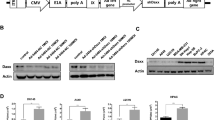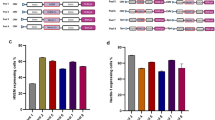Abstract
To improve the expression levels of transgenes in malignant hematopoietic cells, we developed a novel adenoviral-alphavirus hybrid vector Ad5/F11p-SFV-GFP that contains a Semliki Forest Virus (SFV) replicon and chimeric fibers of Ad5 and Ad11p. Ad5/F11p-SFV-GFP infected >95% of K562, U937 or Jurkat cells and 23.65% of HL-60 cells, and led to moderate Enhanced Green Fluorescent Protein (EGFP) transgene expression intensity. The infection efficiency of Ad5/F11p-SFV-GFP in primary human leukemia cells ranged from 9.34–89.63% (median, 28.58%) at a multiplicity of infection (MOI) of 100, compared with only 3.37–44.54% (median, 10.42%) in cells infected by Ad5/F11p-GFP. Importantly, Ad5/F11p-SFV-GFP led to a significantly higher transgene expression level in primary leukemia cells, as indicated by the relative fluorescence intensity, compared to cells infected with Ad5/F11p-GFP. The increased expression of EGFP in Ad5/F11p-SFV-GFP-infected cells was associated with the accumulation of abundant subgenomic mRNA. Additionally, infection of K562, U937 or Jurkat cells by Ad5/F11p-SFV-GFP was significantly inhibited by blocking CD46 receptor; however, other factors may affect the gene-transfer efficiency of Ad5/F11p-SFV-GFP in primary leukemia cells. In conclusion, we successfully developed a novel adenoviral-alphavirus hybrid vector with RNA replicon features, which represents a promising vector for gene modifications during the production of cell-based vaccines for leukemia patients.
This is a preview of subscription content, access via your institution
Access options
Subscribe to this journal
Receive 12 print issues and online access
$259.00 per year
only $21.58 per issue
Buy this article
- Purchase on Springer Link
- Instant access to full article PDF
Prices may be subject to local taxes which are calculated during checkout




Similar content being viewed by others
References
Frecha C, Costa C, Nègre D, Amirache F, Trono D, Rio P et al. A novel lentiviral vector targets gene transfer into human hematopoietic stem cells in marrow from patients with bone marrow failure syndrome and in vivo in humanized mice. Blood 2012; 119: 1139–1150.
Kang HJ, Bartholomae CC, Paruzynski A, Arens A, Kim S, Yu SS et al. Retroviral gene therapy for X-linked chronic granulomatous disease: results from phase I/II trial. Mol Ther 2011; 19: 2092–2101.
Yao XL, Nakagawa S, Gao JQ . Current targeting strategies for adenovirus vectors in cancer gene therapy. Curr Cancer Drug Targets 2011; 11: 810–825.
Trobridge GD . Genotoxicity of retroviral hematopoietic stem cell gene therapy. Expert Opin Biol Ther 2011; 11: 581–593.
Fan H, Johnson C . Insertional oncogenesis by non-acute retroviruses: implications for gene therapy. Viruses 2011; 3: 398–422.
Strauss BE, Costanzi-Strauss E . Combating oncogene activation associated with retrovirus-mediated gene therapy of X-linked severe combined immunodeficiency. Braz J Med Biol Res 2007; 40: 601–613.
Yotnda P, Zompeta C, Heslop HE, Andreeff M, Brenner MK, Marini F . Comparison of the efficiency of transduction of leukemic cells by fiber-modified adenoviruses. Hum Gene Ther 2004; 15: 1229–1242.
Jin J, Liu H, Yang C, Li G, Liu X, Qian Q et al. Effective gene-viral therapy of leukemia by a new fiber chimeric oncolytic adenovirus expressing TRAIL: in vitro and in vivo evaluation. Mol Cancer Ther 2009; 8: 1387–1397.
Lu ZZ, Ni F, Hu ZB, Wang L, Wang H, Zhang QW et al. Efficient gene transfer into hematopoietic cells by a retargeting adenoviral vector system with a chimeric fiber of adenovirus serotype 5 and 11p. Exp Hematol 2006; 34: 1171–1182.
Casales E, Aranda A, Quetglas JI, Ruiz-Guillen M, Rodriguez-Madoz JR, Prieto J et al. A novel system for the production of high levels of functional human therapeutic proteins in stable cells with a Semliki Forest virus noncytopathic vector. N Biotechnol 2010; 27: 138–148.
Liljeström P, Garoff H . A new generation of animal cell expression vectors based on the Semliki Forest virus replicon. Biotechnology (NY) 1991; 9: 1356–1361.
Xiong C, Levis R, Shen P, Schlesinger S, Rice CM, Huang HV . Sindbis virus: an efficient, broad host range vector for gene expression in animal cells. Science 1989; 243: 1188–1191.
Pushko P, Parker M, Ludwig GV, Davis NL, Johnston RE, Smith JF . Replicon-helper systems from attenuated Venezuelan equine encephalitis virus: expression of heterologous genes in vitro and immunization against heterologous pathogens in vivo. Virology 1997; 239: 389–401.
Kahl CA, Pollok K, Haneline LS, Cornetta K . Lentiviral vectors pseudotyped with glycoproteins from Ross River and vesicular stomatitis viruses: variable transduction related to cell type and culture conditions. Mol Ther 2005; 11: 470–482.
Cornwell RD, Gollahon KA, Hickstein DD . Description of the leukocyte function-associated antigen 1 (LFA-1 or CD11a) promoter. Proc Natl Acad Sci USA 1993; 90: 4221–4225.
Sirena D, Lilienfeld B, Eisenhut M, Kälin S, Boucke K, Beerli RR et al. The human membrane cofactor CD46 is a receptor for species B adenovirus serotype 3. J Virol 2004; 78: 4454–4462.
Wang H, Li ZY, Liu Y, Persson J, Beyer I, Möller T et al. Desmoglein 2 is a receptor for adenovirus serotypes 3, 7, 11 and 14. Nat Med 2011; 17: 96–104.
Rhême C, Ehrengruber MU, Grandgirard D . Alphaviral cytotoxicity and its implication in vector development. Exp Physiol 2005; 90: 45–52.
Barry G, Fragkoudis R, Ferguson MC, Lulla A, Merits A, Kohl A et al. Semliki forest virus-induced endoplasmic reticulum stress accelerates apoptotic death of mammalian cells. J Virol 2010; 84: 7369–7377.
Urban C, Rhême C, Maerz S, Berg B, Pick R, Nitschke R et al. Apoptosis induced by Semliki Forest virus is RNA replication dependent and mediated via Bak. Cell Death Differ 2008; 15: 1396–1407.
Gershan JA, Johnson BD, Weber J, Schauer DW, Natalia N, Behnke S et al. Immediate transfection of patient-derived leukemia: a novel source for generating cell-based vaccines. Genet Vaccines Ther 2005; 3: 4.
Ingram W, Kordasti S, Chan L, Barber LD, Tye GJ, Hardwick N et al. Human CD80/IL2 lentivirus transduced acute myeloid leukaemia cells enhance cytolytic activity in vitro in spite of an increase in regulatory CD4+ T cells in a subset of cultures. Cancer Immunol Immunother 2009; 58: 1679–1690.
Saudemont A, Corm S, Wickham T, Hetuin D, Quesnel B . Induction of leukemia-specific CD8+ cytotoxic T cells with autologous myeloid leukemic cells maturated with a fiber-modified adenovirus encoding TNF-alpha. Mol Ther 2005; 11: 950–959.
Anderson R, Macdonald I, Corbett T, Hacking G, Lowdell MW, Prentice HG . Construction and biological characterization of an interleukin-12 fusion protein (Flexi-12): delivery to acute myeloid leukemic blasts using adeno-associated virus. Hum Gene Ther 1997; 8: 1125–1135.
Guan M, Rodriguez-Madoz JR, Alzuguren P, Gomar C, Kramer MG, Kochanek S et al. Increased efficacy and safety in the treatment of experimental liver cancer with a novel adenovirus-alphavirus hybrid vector. Cancer Res 2006; 66: 1620–1629.
Sun Y, Li HY, Tian DY, Han QY, Zhang X, Li N et al. A novel alphavirus replicon-vectored vaccine delivered by adenovirus induces sterile immunity against classical swine fever. Vaccine 2011; 29: 8364–8372.
Köchling J, König-Merediz SA, Stripecke R, Buchwald D, Korte A, Von Einsiedel HG et al. Protection of mice against Philadelphia chromosome-positive acute lymphoblastic leukemia by cell-based vaccination using nonviral, minimalistic expression vectors and immunomodulatory oligonucleotides. Clin Cancer Res 2003; 9: 3142–3149.
Acknowledgements
This work was supported by grants from the Chinese National Basic Research and Development (973 Program) (no. 2012CB518205), the National Natural Science Foundation of China (nos. 30901379 and 81170460), and the National High Technology Research and Development Program of China (863 Program) (no. 2012AA02A211).
Author information
Authors and Affiliations
Corresponding authors
Ethics declarations
Competing interests
The authors declare no conflict of interest.
Rights and permissions
About this article
Cite this article
Yang, Y., Xiao, F., Lu, Z. et al. Development of a novel adenovirus–alphavirus hybrid vector with RNA replicon features for malignant hematopoietic cell transduction. Cancer Gene Ther 20, 429–436 (2013). https://doi.org/10.1038/cgt.2013.37
Received:
Revised:
Accepted:
Published:
Issue Date:
DOI: https://doi.org/10.1038/cgt.2013.37



